추천 제품
설명
Methacrylated collagen:
Degree of methacrylation ≥ 20%
Product components :
Methacrylated collagen (100 mg)
20 mM acetic acid (50 mL)
Neutralization solution (10 mL)
Ruthenium (100 mg)
Sodium persulfate photoinitiator (500 mg)
Quality Level
무균
sterile; sterile-filtered
불순물
≤10 EU/mL Endotoxin
저장 온도
2-8°C
애플리케이션
PhotoCol™-RUT bioink kit consists of purified methacrylated Type I bovine collagen as the core component with other support reagents. The methacrylated Type I collagen is produced from telo-peptide intact bovine collagen where the collagen has been modified by reacting the free amines, primarily the ε-amines groups of the lysine residues as well as the α-amines groups on the N-termini. Over 20% of the total lysine residues of the collagen molecule have been methacrylated. A bottle of 20 mM acetic acid solution is provided to solubilize the lyophilized methacrylated collagen at concentrations ranging from 3 to 8 mg/ml. The neutralization solution consists of an alkaline 10X phosphate buffered saline (PBS) solution which provides physiological salts and pH in the final mixture. The photoinitiator consists of ruthenium and sodium persulfate to be formulated in 1X cell culture media or PBS, which allows visible light photocrosslinking of the printed structure at 400-450 nm. PhotoCol™-RUT provides native-like 3D collagen gels, and the final gel stiffness can be customized by changing collagen concentrations and crosslinking.
법적 정보
PhotoCol is a trademark of Advanced BioMatrix, Inc.
유해 및 위험 성명서
예방조치 성명서
Hazard Classifications
Aquatic Chronic 2
Storage Class Code
10 - Combustible liquids
시험 성적서(COA)
제품의 로트/배치 번호를 입력하여 시험 성적서(COA)을 검색하십시오. 로트 및 배치 번호는 제품 라벨에 있는 ‘로트’ 또는 ‘배치’라는 용어 뒤에서 찾을 수 있습니다.
Ian D Gaudet et al.
Biointerphases, 7(1-4), 25-25 (2012-05-17)
Type-I collagen is an attractive scaffold material for tissue engineering due to its ability to self-assemble into a fibrillar hydrogel, its innate support of tissue cells through bioactive adhesion sites, and its biodegradability. However, a lack of control of material
Andrea Mazzocchi et al.
ACS biomaterials science & engineering, 5(4), 1937-1943 (2019-11-15)
Lung cancer is the leading cause of cancer-related death worldwide yet in vitro disease models have been limited to traditional 2D culture utilizing cancer cell lines. In contrast, recently developed 3D models (organoids) have been adopted by researchers to improve
UV-Assisted 3D Bioprinting of Nanoreinforced Hybrid Cardiac Patch for Myocardial Tissue Engineering.
Mohammad Izadifar et al.
Tissue engineering. Part C, Methods, 24(2), 74-88 (2017-10-21)
Biofabrication of cell supportive cardiac patches that can be directly implanted on myocardial infarct is a potential solution for myocardial infarction repair. Ideally, cardiac patches should be able to mimic myocardium extracellular matrix for rapid integration with the host tissue
Apekshya Chhetri et al.
Current protocols in chemical biology, 11(2), e65-e65 (2019-06-06)
With the increase in knowledge on the importance of the tumor microenvironment, cell culture models of cancers can be adapted to better recapitulate physiologically relevant situations. Three main microenvironmental factors influence tumor phenotype: the biochemical components that stimulate cells, the
Erin Maloney et al.
Micromachines, 11(2) (2020-02-23)
The current drug development pipeline takes approximately fifteen years and $2.6 billion to get a new drug to market. Typically, drugs are tested on two-dimensional (2D) cell cultures and animal models to estimate their efficacy before reaching human trials. However
자사의 과학자팀은 생명 과학, 재료 과학, 화학 합성, 크로마토그래피, 분석 및 기타 많은 영역을 포함한 모든 과학 분야에 경험이 있습니다..
고객지원팀으로 연락바랍니다.









